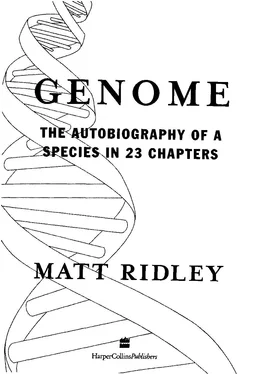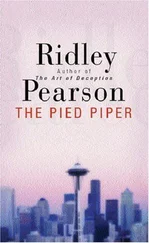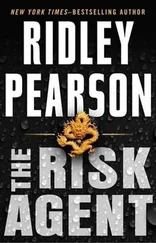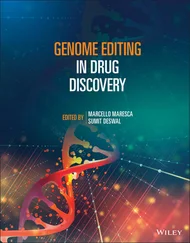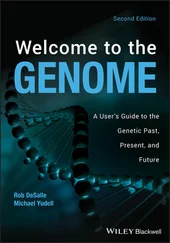Genome - Matt Ridley
Здесь есть возможность читать онлайн «Genome - Matt Ridley» — ознакомительный отрывок электронной книги совершенно бесплатно, а после прочтения отрывка купить полную версию. В некоторых случаях можно слушать аудио, скачать через торрент в формате fb2 и присутствует краткое содержание. Жанр: Старинная литература, на английском языке. Описание произведения, (предисловие) а так же отзывы посетителей доступны на портале библиотеки ЛибКат.
- Название:Matt Ridley
- Автор:
- Жанр:
- Год:неизвестен
- ISBN:нет данных
- Рейтинг книги:5 / 5. Голосов: 1
-
Избранное:Добавить в избранное
- Отзывы:
-
Ваша оценка:
- 100
- 1
- 2
- 3
- 4
- 5
Matt Ridley: краткое содержание, описание и аннотация
Предлагаем к чтению аннотацию, описание, краткое содержание или предисловие (зависит от того, что написал сам автор книги «Matt Ridley»). Если вы не нашли необходимую информацию о книге — напишите в комментариях, мы постараемся отыскать её.
Matt Ridley — читать онлайн ознакомительный отрывок
Ниже представлен текст книги, разбитый по страницам. Система сохранения места последней прочитанной страницы, позволяет с удобством читать онлайн бесплатно книгу «Matt Ridley», без необходимости каждый раз заново искать на чём Вы остановились. Поставьте закладку, и сможете в любой момент перейти на страницу, на которой закончили чтение.
Интервал:
Закладка:
4 4 G E N O M E
For four years, starting in 1866, Mendel sent his papers and his ideas to Karl-Wilhelm Nageli, professor of botany in Munich. With increasing boldness he tried to point out the significance of what he had found. For four years Nageli missed the point. He wrote back to the persistent monk polite but patronising letters, and told him to try breeding hawkweed. He could not have given more mischievous advice if he tried: hawkweed is apomictic, that is it needs pollen to breed but does not incorporate the genes of the pollinating partner, so cross-breeding experiments give strange results. After struggling with hawkweed Mendel gave up and turned to bees. The results of his extensive experiments on the breeding of bees have never been found. Did he discover their strange 'haplo-diploid' genetics?
Nageli meanwhile published an immense treatise on heredity that not only failed to mention Mendel's discovery; it also gave a perfect example of it from Nageli's own work - and still missed the point.
Nageli knew that if you crossed an angora cat with another breed, the angora coat disappeared completely in the next generation, but re-emerged intact in the kittens of the third generation. A clearer example of a Mendelian recessive could hardly be found.
Yet even in his lifetime Mendel came tantalisingly close to full recognition. Charles Darwin, normally so diligent at gleaning ideas from the work of others, even recommended to a friend a book, by W. O. Focke, that contained fourteen different references to Mendel's paper. Yet he seems not to have noticed them himself.
Mendel's fate was to be rediscovered, in 1900, long after his own and Darwin's deaths. It happened almost simultaneously in three different places. Each of his rediscoverers — Hugo de Vries, Carl Correns and Erich von Tschermak, all botanists - had laboriously duplicated Mendel's work on different species before he found Mendel's paper.
Mendelism took biology by surprise. Nothing about evolutionary theory demanded that heredity should come in lumps. Indeed, the notion seemed to undermine everything that Darwin had strived to establish. Darwin said that evolution was the accumulation of slight H I S T O R Y 4 5
and random changes through selection. If genes were hard things that could emerge intact from a generation in hiding, then how could they change gradually or subtly? In many ways, the early twentieth century saw the triumph of Mendelism over Darwinism.
William Bateson expressed the views of many when he hinted that particulate inheritance at least put limits on the power of natural selection. Bateson was a man with a muddled mind and a leaden prose style. He believed that evolution occurred in large leaps from one form to another leaving no intermediates. In pursuit of this eccentric notion, he had published a book in 1894 arguing that inheritance was particulate and had been furiously attacked by 'true'
Darwinists ever since. Little wonder he welcomed Mendel with open arms and was the first to translate his papers into English. 'There is nothing in Mendelian discovery which runs counter to the cardinal doctrine that species have arisen [by natural selection]', wrote Bateson, sounding like a theologian claiming to be the true interpreter of St Paul. 'Nevertheless, the result of modern inquiry has unquestionably been to deprive that principle of those supernatural attributes with which it has sometimes been invested . . . It cannot in candour be denied that there are passages in the works of Darwin which in some measure give countenance to these abuses of the principle of Natural Selection, but I rest easy in the certainty that had Mendel's paper come into his hands, those passages would have been immediately revised.'4
But the very fact that the dreaded Bateson was Mendelism's champion led European evolutionists to be suspicious of it. In Britain, the bitter feud between Mendelians and 'biometricians' persisted for twenty years. As much as anything this passed the torch to the United States where the argument was less polarised. In 1903
an American geneticist called Walter Sutton noticed that chromosomes behave just like Mendelian factors: they come in pairs, one from each parent. Thomas Hunt Morgan, the father of American genetics, promptly became a late convert to Mendelism, so Bateson, who disliked Morgan, gave up being right and fought against the chromosomal theory. By such petty feuds is the history of science 4 6 G E N O M E
often decided. Bateson sank into obscurity while Morgan went on to great things as the founder of a productive school of genetics and the man who lent his name to the unit of genetic distance: the centimorgan. In Britain, it was not until the sharp, mathematical mind of Ronald Fisher was brought to bear upon the matter in 1918
that Darwinism and Mendelism were at last reconciled: far from contradicting Darwin, Mendel had brilliantly vindicated him.
'Mendelism', said Fisher, 'supplied the missing parts of the structure erected by Darwin.'
Yet the problem of mutation remained. Darwinism demanded variety upon which to feed. Mendelism supplied stability instead. If genes were the atoms of biology, then changing them was as heretical as alchemy. The breakthrough came with the first artificial induction of mutation by somebody as different from Garrod and Mendel as could be imagined. Alongside an Edwardian doctor and an Augustinian friar we must place the pugnacious Hermann Joe Muller.
Muller was typical of the many brilliant, Jewish scientific refugees crossing the Atlantic in the 1930s in every way except one: he was heading east. A native New Yorker, son of the owner of a small metal-casting business, he had been drawn to genetics at Columbia University, but fell out with his mentor, Morgan, and moved to the University of Texas in 1920. There is a whiff of anti-semitism about Morgan's attitude to the brilliant Muller, but the pattern was all too typical. Muller fought with everybody all his life. In 1932, his marriage on the rocks and his colleagues stealing his ideas (so he said), he attempted suicide, then left Texas for Europe.
Muller's great discovery, for which he was to win the Nobel prize, was that genes are artificially mutable. It was like Ernest Rutherford's discovery a few years before that atomic elements were transmutable and that the word 'atom', meaning in Greek uncuttable, was inappropriate. In 1926, he asked himself, '[Is] mutation unique among biological processes in being itself outside the reach of modification or control, — that it occupies a position similar to that till recently characteristic of atomic transmutation in physical science?'
The following year he answered the question. By bombarding H I S T O R Y 4 7
fruit flies with X-rays, Muller caused their genes to mutate so that their offspring sported new deformities. Mutation, he wrote, 'does not stand as an unreachable god playing its pranks upon us from some impregnable citadel in the germplasm.' Like atoms, Mendel's particles must have some internal structure, too. They could be changed by X-rays. They were still genes after mutation, but not the same genes.
Artificial mutation kick-started modern genetics. Using Muller's X-rays, in 1940 two scientists named George Beadle and Edward Tatum created mutant versions of a bread mould called Neurospora.
They then worked out that the mutants failed to make a certain chemical because they lacked the working version of a certain enzyme. They proposed a law of biology, which caught on and has proved to be more or less correct: one gene specifies one enzyme.
Geneticists began to chant it under their breath: one gene, one enzyme. It was Garrod's old conjecture in modern, biochemical detail. Three years later came Linus Pauling's remarkable deduction that a nasty form of anaemia afflicting mostly black people, in which the red cells turned into sickle shapes, was caused by a fault in the gene for the protein haemoglobin. That fault behaved like a true Mendelian mutation. Things were gradually falling into place: genes were recipes for proteins; mutations were altered proteins made by altered genes.
Читать дальшеИнтервал:
Закладка:
Похожие книги на «Matt Ridley»
Представляем Вашему вниманию похожие книги на «Matt Ridley» списком для выбора. Мы отобрали схожую по названию и смыслу литературу в надежде предоставить читателям больше вариантов отыскать новые, интересные, ещё непрочитанные произведения.
Обсуждение, отзывы о книге «Matt Ridley» и просто собственные мнения читателей. Оставьте ваши комментарии, напишите, что Вы думаете о произведении, его смысле или главных героях. Укажите что конкретно понравилось, а что нет, и почему Вы так считаете.
